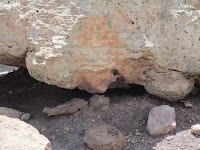But it was really, really cool. The Morrison Formation is absolutely full of dinosaur material and tracks, but I didn't realize just how much material is around the quarry. As in, within a couple of miles of it.
For example, the "Cleveland Lloyd Therapod Trackway!" It has two footprints pointing in perpendicular directions to each other (one to the left of Mike's foot and one to the right.) It's almost as if this 'little' guy changed directions mid step, or took a step back that is now long gone from the rock.
Yes, its a trackway...
Maybe he saw something over there he wanted to eat. Or something that wanted to eat him.
 The other type of track that we see a lot of are sauropod track ways. You know, the big guys with the long necks.
The other type of track that we see a lot of are sauropod track ways. You know, the big guys with the long necks.The front of their foot forms a lima bean shaped indent, and the back forms a circular one. The lima bean shape is pretty diagnostic, but the other one alone is hard to distinguish from another lump in the rock.

And they're eroding out of everywhere around here.
Everywhere. Look under that rock. These tracks form the shape of the foot rather than the imprint of the foot because the rock that filled in the tracks was more resistant to erosion that the sediment that the dinosaur original stepped in. Thus we get the actual foot shape, like a cast!
So there's a problem on this tour.
That lima bean shape doesn't form by itself.
 So here, allow me to present monster-sauropod, a footprint bigger than the foot of any sauropod known in this area at the time it was made. Sure, it could be due to the foot shifting or the print deforming before it was preserved. However, there is another one exactly like it over the hill.
So here, allow me to present monster-sauropod, a footprint bigger than the foot of any sauropod known in this area at the time it was made. Sure, it could be due to the foot shifting or the print deforming before it was preserved. However, there is another one exactly like it over the hill.Shifting and preservation errors? No longer a likely option.
Somewhere is those hills, a big guy awaits discovery. A really, really big guy.

Now that I'm done scaring you, lets talk about some cool geology. These are called desert roses, or barite roses. They form when there is a lot of carbon in the atmosphere, as there was during the Jurassic. This leads to acid rain, which reacts with caliche (calcium carbonate, most importantly here the calcite.) Then evaporation happens, leaving crystals, which were then later replaced with a denser mineral called barium, forming these... odd structures.
 O...K... now lets talk about something I kinda know better.
O...K... now lets talk about something I kinda know better. This is one of my favorite things to mess with people with. Its a COPROLITE! Know what that is? Fossilized... POOP! Um. Excuse me. Scat is the nice word I believed.
Anyway, this particular type is the droppings of a therapod. You can tell because the white in is digested bone, and that's what carnivore would have been around at the time. Carnivore scat is more likely to preserve than herbivore because its composed of harder material. Bone. As a result, we know a little more about it than the herbivore scat. I mean... they had to drop it. We just don't find it often. Same goes for their stomach contents, which actually leaves the question open as to what plants they were actually eating.
No question here though. This guy was hungry for meat, and not picky crunching up bone.

No comments:
Post a Comment